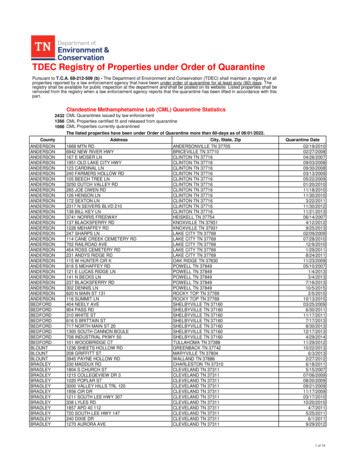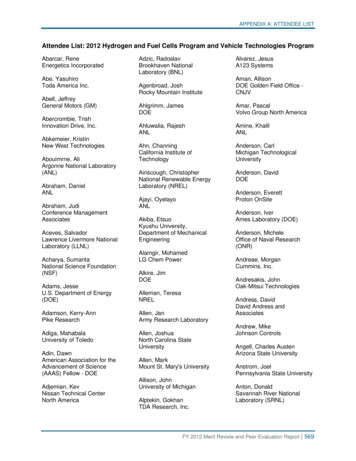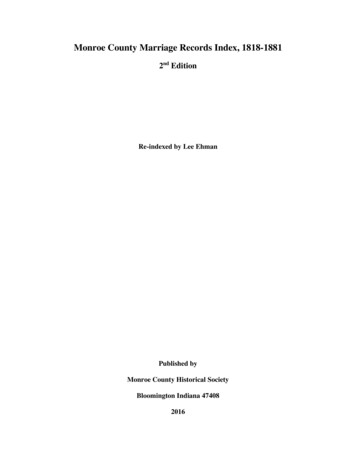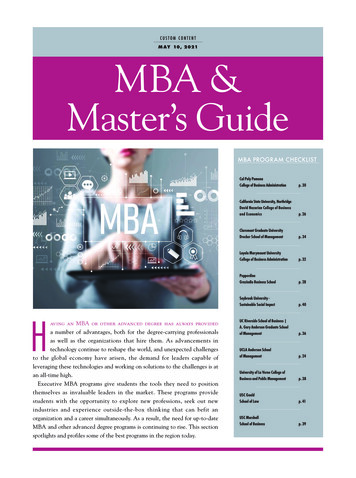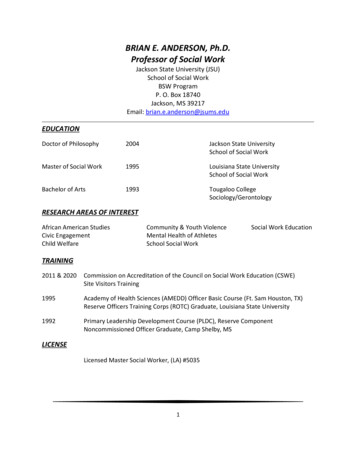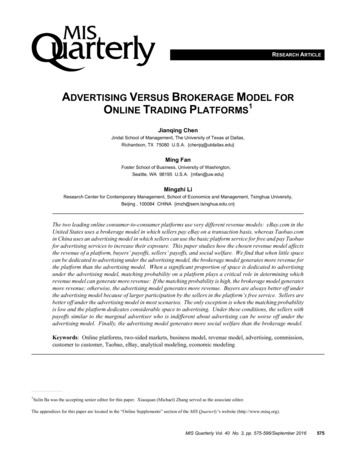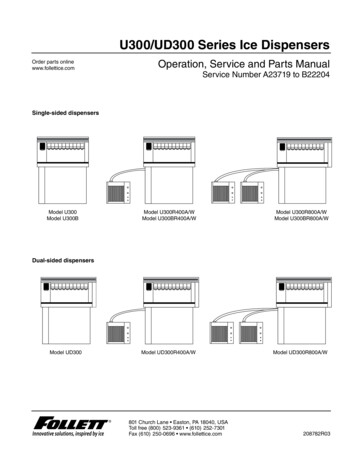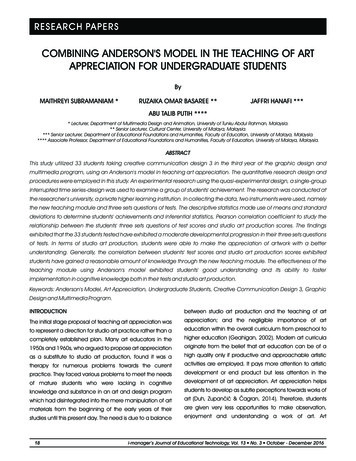
Transcription
RESEARCH PAPERSCOMBINING ANDERSON'S MODEL IN THE TEACHING OF ARTAPPRECIATION FOR UNDERGRADUATE STUDENTSByMAITHREYI SUBRAMANIAM *RUZAIKA OMAR BASAREE **JAFFRI HANAFI ***ABU TALIB PUTIH ***** Lecturer, Department of Multimedia Design and Animation, University of Tunku Abdul Rahman, Malaysia.** Senior Lecturer, Cultural Center, University of Malaya, Malaysia.*** Senior Lecturer, Department of Educational Foundations and Humanities, Faculty of Education, University of Malaya, Malaysia.**** Associate Professor, Department of Educational Foundations and Humanities, Faculty of Education, University of Malaya, Malaysia.ABSTRACTThis study utilized 33 students taking creative communication design 3 in the third year of the graphic design andmultimedia program, using an Anderson's model in teaching art appreciation. The quantitative research design andprocedures were employed in this study. An experimental research using the quasi-experimental design, a single-groupinterrupted time series-design was used to examine a group of students' achievement. The research was conducted atthe researcher's university, a private higher learning institution. In collecting the data, two instruments were used, namelythe new teaching module and three sets questions of tests. The descriptive statistics made use of means and standarddeviations to determine students' achievements and inferential statistics, Pearson correlation coefficient to study therelationship between the students' three sets questions of test scores and studio art production scores. The findingsexhibited that the 33 students tested have exhibited a moderate developmental progression in their three sets questionsof tests. In terms of studio art production, students were able to make the appreciation of artwork with a betterunderstanding. Generally, the correlation between students' test scores and studio art production scores exhibitedstudents have gained a reasonable amount of knowledge through the new teaching module. The effectiveness of theteaching module using Anderson's model exhibited students' good understanding and its ability to fosterimplementation in cognitive knowledge both in their tests and studio art production.Keywords: Anderson's Model, Art Appreciation, Undergraduate Students, Creative Communication Design 3, GraphicDesign and Multimedia Program.INTRODUCTIONbetween studio art production and the teaching of artThe initial stage proposal of teaching art appreciation wasappreciation; and the negligible importance of artto represent a direction for studio art practice rather than aeducation within the overall curriculum from preschool tocompletely established plan. Many art educators in thehigher education (Geahigan, 2002). Modern art curricula1950s and 1960s, who argued to propose art appreciationoriginate from the belief that art education can be of aas a substitute to studio art production, found it was ahigh quality only if productive and approachable artistictherapy for numerous problems towards the currentactivities are employed. It pays more attention to artisticpractice. They faced various problems to meet the needsdevelopment or end product but less attention in theof mature students who were lacking in cognitivedevelopment of art appreciation. Art appreciation helpsknowledge and substance in an art and design programstudents to develop as subtle perceptions towards works ofwhich had disintegrated into the mere manipulation of artart (Duh, Zupančič & Čagran, 2014). Therefore, studentsmaterials from the beginning of the early years of theirare given very less opportunities to make observation,studies until this present day. The need is due to a balanceenjoyment and understanding a work of art. Art18i-manager’s Journal of Educational Technology, Vol. 13 lNo. 3 lOctober - December 2016
RESEARCH PAPERSappreciation involves stimuli, persons and contexts thatof an aesthetic experience, which associates the observerneeded to be embedded in the early age (Schabmann,of the natural world by motivating contemplation andGerger, Schmidt, Wögerer, Osipov & Leder, 2016).remembrance. Also, another theme involved where theThe art appreciation process is usually formative in type,creative process of the artists; whereby all of themintended to assist students to develop their aptitudes tocultivated their own relationships and acquiring theproduce visuals better and think critically about the visualsenvironmentalism of places. Ultimately, the artists are ableintrinsic qualities (Eisner, 2002; Motley, 2015). In currentto develop a sense of place, environmental issues and artpractices of art education, artistic knowledge is needed inappreciation of the environment. On the other hand,helping the students to understand their studio artDavidson (2009) used Anderson's model in examiningproductions better. One of the common approaches usedAfrican American quilt artists in finding out the meaning andto enhance students' artistic knowledge is teaching themsignificance they see by making a critical connection andart appreciation. Using this approach, students are not onlyappreciation to art education theory and practice. Theexposed to studio art production, but also enhance theirresearcher suggested there should be more instructionalcognitive skills that they can carry out in their studio artresources developed to be used in the studio classroom.productions (Maithreyi Subramaniam, Jaffri Hanafi & AbuFurthermore, Davidson suggested there should be anTalib Putih, 2016). Students are not only mastery of theirabundant amount of the art tools for quilting in the studiomotor skill, but more importantly their cognitive knowledgeclassroom for a quality and holistic art program. However,and affective domain; at the same time problem solvingLampert (2015) found that the Anderson's model certainlybecomes better; not just the creation, but students canonly for art history.synthesize their ideas within the superior contextual1.2 Anderson Model (1988)structure of the subject. Through the transformation ofAnderson's art appreciation learning model emphasizes onaffective domain, it is discovered that cognitive knowledgecritical thinking because the model emphasizes thinkingis found to be an important emotional process in makingskills, namely the ability to analyze, deduce and decisionan appreciation (Schabmann, et al., 2016). Without themaking depending on personal incorporated criteria, andprocess of art appreciation, students may be at risk, loosingability to understand the consequences of decisioninterest in the workings of their own ideas; which itmaking (Anderson, 1988 & 1993). The researcher's modelsignificantly affects the art classroom teaching andfor art appreciation is designed pedagogically, an effort tolearning process.incorporate affective and intuitive thinking with logical and1. Literature Reviewintellectual ways of observing and seeing or perceiving1.1 The Use of Anderson's Model in Art EducationRecent findings in using Anderson's model were significantto enhance the process of making an art appreciationtowards a work of art. Barret (2014) emphasizes thatAnderson's model contains an interesting approachworks of art. Also, Hosseini Mehdi and Darabi Helia (2016)agreed that Anderson's model emphasizes on personaland emotional encounter with a work of art. The steps in themodel contextually composed of five stages, namelyreaction, perceptual analysis, personal interpretation,towards art appreciation in learning art history. JooheeKang (2010) has approached it in terms of contextual artcriticism by analyzing the works of art. The researcher foundthat students as artists were able to share a holisticworldview, which is a belief in the fundamentalinterconnectedness of all life. Additional subjects thatemerged included artists' usual depictions of nature asintrinsically spiritual and powerful, and their establishmentFigure 1. Anderson's Model of Art Appreciation, 1988.i-manager’s Journal of Educational Technology, Vol. 13 lNo. 3 lOctober - December 201619
RESEARCH PAPERScontextual examination and synthesis (Figure 1). Followingeducational criticism.is a detail explanation of each step of this model:1.2.3 Personal Interpretation1.2.1 ReactionAt this stage, the students are expected to think with feelingAt this first stage, the students react towards how the work ofand feel their thoughts in relation to the work's expressiveart makes them feel. This consists of an initial, global, andand emotional content and meaning. Meaning that isdeeply intuitive and evaluative response.projected is a synthesis of the perceptual information1.2.2 Perceptual Analysisgathered from the initial response and developingThe second stage, the students begin search to determinewhy they felt the reaction. It involves a description of theobjective and observable or apparent qualities thatstimulated the preliminary response.·It starts with representation of the most evident qualitiesthat generated interest. These inclusive of subject matterrelating to theme, visual elements and apparenttechniques or skills used in the work of art. This perceptualanalysis ought to deepen and attend to progressivelysubtle qualities as criticism continues. In this descriptiveprocess, the preliminary intuition can change because offinding hidden evidence. This change must be allowedinvestigation of content, form and character. This stagefound to be a major switch in cognitive functions fromanalytic to synthetically intuitive projection. In the criticalprocess, this stage of creative projection students isexpected to refer back to the visual evidence so that theystay in the attribution of the object or event being criticized.Effective interpretation conveys the personal associativeexperience to endure, which forms are intentions withmeaning, and works of art convey meanings beyond just asurface form.1.2.4 Contextual ExaminationThe students research the contextual and historicalinformation. Contextual examination comprises the who,during this process.·The second operation of this stage is a deeper stage ofdescription that consists of formal analysis. The emphasis ofthis stage is on discovering connections between formsand among forms and theme based content. Meaning ina work of art always depends where the significantwhat, when, where, why and how the surroundings of thework of art. This stage provides added perspective, such asvisual symbols, social, political, religious, historical andeconomic influences. It is the evidence gained about thework of art rather than from it.connections are discovered. Principles of design found to1.2.5 Synthesisbe a good analytical tool to be applied at this stage.The students reach the final stage by synthesizing the workStudents must be directed to try each of these principles ofof art that is constructed upon contextual examination.design to see if it fits, and how and why. They must discardThere are two procedures in this stage, namely resolutionprinciples of design that are not suitable to fit the settingand evaluation. The first, resolution resolves personal orand apply the ones that can find points of meaning.interactively established analyses with those of the experts·The last operation of perceptual analysis is formalas determined in the previous stage. Recalling that thecharacterization. How style conveys the subject matter is atpower of visual imagery lies in a presentational nature-the heart of meaning in works of art. Hence, it is significant towhich means different things to different people, numerousdistinguish the formal qualities with some sensitivity. This is ameanings must be entertained. Students who couldcombination of analysis and creative projection that leadsprovide evidence for meaning which runs counter to theto interpretation. Formal characterization could very wellprofessionals, or even the artist's, and at the same time canbe a more complex and profound review of the initialpoint out the visual evidences, have to be valued for theirresponse, if that response still fits, or it may be veryviews. At the present, aesthetic inquiries can develop, fordistinctive. Formal characterization could be ratherexample, as to whether the artist is the final word onwidespread, but also could be fairly brief in terms ofmeaning in the work of arts. Questions related to this are:Does the artist have more right to establish the meaning20i-manager’s Journal of Educational Technology, Vol. 13 lNo. 3 lOctober - December 2016
RESEARCH PAPERSthan the educated observer? If we as observers refuse to5. Methodologyagree with the artist at his or her word can we disregard thatThe methodology comprises of a standard form, namely:word completely? How can we blend the explanation we(i)came up with, artist or others. This is a suitable time for asamples, (iv) Instruments, and (v) Reliability and validity ofteacher to begin with aesthetic theory, issues related tothe instruments.artistic intentionalism (Anderson, 1988).2. Signficance of the StudyThe significances of this study are:·This study connects the Anderson's model in theteaching of art appreciation;Research design, (ii) Description of the method, (iii)5.1 Research DesignThe quantitative research was a suitable research design andprocedures used to study in this research. This quantitativeresearch was used for testing objective theories byexamining the relationship between variables—module·This study examines the variable that is the module andusing an Anderson's model for art appreciation and creativesees the effect of Anderson's model of the newcommunication subject 3. This research design used thesituation in the creative communication design 3; and·This study tests the new instrument built to increase thestudents' art appreciation knowledge in the creativecommunication design 3.3. Research ObjectivesThe statements of research objectives serve to guide thisresearch activity, namely:·To quantify the scores concerning students'achievement levels in creative communicationdesign 3 subject;closed-ended questions for the creative communicationdesign 3 module and three sets questions of tests. Thesevariables were then measured, typically on instruments, sothat numbered data can be analyzed using the statisticalprocedures using SPSS version 21.5.2 Description of MethodAn experimental research was employed to determine ifthe specific treatment given to the group of studentinfluences an outcome. This impact is assessed byproviding a specific treatment to the group anddetermining scores on an outcome. The method·To measure the relationship between students' threeemployed is quasi-experimental design that does notset questions of test scores and lesson (studio artinclude the use of random assignment to control threats toproduction) scores; andinternal validity. A single-group interrupted time series-·To determine the effectiveness of Anderson's model inthe teaching of art appreciation.4. Research QuestionsThe following are the research questions of this study.·RQ 1: What is the students' three sets questions of testsmean score conducted for creative communicationdesign 3 subject?·RQ 2: What is the students' lesson (studio art production)mean score?design was used to examine this group of students'achievement by repeated measurements or observationsover a period of time both before and after treatment. Inthis instance, because one experimental group wasemployed, involving several treatments, a modified versionof this experimental design was used. This modified versionis provided in the following diagram (Figure 2).This experimental group experienced three set questions oftest in week 1 (X1 pre-test: test 1), week 7 (X2 middle-test:test 3), and lastly in week 14 (X3 post-test: test 3) every time·RQ 3: What are the relationships between the students'three set questions of test scores and lesson (studio artproduction) scores?·RQ 4: What are the mean scores of lessons (studio artproduction) for art appreciation knowledge based onFigure 2. Modified Quasi Experimental Designthe five dimensions of Anderson's model?i-manager’s Journal of Educational Technology, Vol. 13 lNo. 3 lOctober - December 201621
RESEARCH PAPERSin between 7 weeks and (O) is a treatment. The reason fortime from one test administration to another. To evaluatechoosing a time-series design is basically determined bythe students' solutions, three raters were recruited: which allanalyzing the pattern of test scores that resulted from theof them are art educators and infield-expertise in thethree tests. Also, only a small group of students participatedcreative communication design 3 subject. The reliabilityin this research, as the program was a unique course. Atest treated as a pilot study was done on ten students' studiolarge amount of data was collected from this group ofart production and three sets questions of tests. A finalstudents.calculation was created for an average score for eachstudent. Once the ratings from the three raters had been5.3 SamplesThe subject was selected using a nonrandom samplingmethod used in this study. The researcher does not simplystudy whomever is available, but uses the judgment toselect a sample based on prior information and providethe data that are needed. The purposive samplingtechnique was used because the researcher focused on aparticular group of participants that has the particularcriteria, which can provide the needed data. The criteria ofthe subjects for this study were students enrolled in acreative communication design 3 subject in the third yeargraphic design and multimedia program taught by theresearcher. The 33 students comprised 12 males and 21females who have completed their O-level.5.4 Instrumentsobtained, an inter-rater reliability analysis, based onCronbach's alpha coefficient, was conducted. Theacceptable value of the test to be considered reliable inthis study is 0.5 alpha and above. The higher the value is thehigher consistency and reliability of the instruments. Theanalysis yielded good reliability (.831 to .877) across all thescales for studio art production. The researcheradministered three sets questions of tests and three times tothe same participants at a sufficient time interval—week 1,week 7 and week 14. The reliability test was used on theraters assessment as all three of them gave marks using thesame assessment; therefore they should attain the sameresults. The reliability test used was Cronbach's Alpha to testthe test-retest questions completed by the students. Theanalysis yielded good reliability (.813 to .877) across all theThe researcher used two types of subject instruments tocheck on the participants' achievements. The instruments,namely subject instruments were used to measure,observe and documenting the quantitative data. Thesubject instruments employed to gather the numericalportion of the data were: (i) a new teaching module usingscales.6. FindingsRQ 1: What is the students' three sets questions of testsmean score conducted for creative communicationdesign 3 subject?an Anderson's model of art appreciation (performanceAs illustrated in Table 1, the mean score comparisonsinstrument); and (ii) three sets questions of tests (written-among tests are presented for pre-test, middle-test, andresponse instrument). These instruments are suitablepost-test scores. A sample of 33 students (N 33)because it has a strong significance towards the researchparticipated in this experiment. In the pre-test, the meanissue discussed in the study.score is 28.82 (SD 10.55), but there is an improvement in5.5 Reliability and Validity of the InstrumentsThe reliability and validity of this research comprised of twocomponents, namely (i) a new teaching module using anAnderson's model of art appreciation and (ii) three setsthe middle test with a mean score of 43.56 (SD 10.02). Inthe post-test, the mean score is 61.12 (SD 8.46) indicatesstudents have performed better in their final test.RQ 2: What is the students' lesson (studio art production)questions of tests (written-response instrument). Reliabilitytest was conducted for both instruments to test the validity,consistency and reliability of the data analysis procedure.The test-retest reliability procedures were used to examinethe extent to which scores from one sample are stable over22Mean (M)NStd. Deviation 33310.5510.028.46Table 1. Mean Score Comparison among Testsi-manager’s Journal of Educational Technology, Vol. 13 lNo. 3 lOctober - December 2016
RESEARCH PAPERSmean score?As illustrated in Table 2, the mean score comparisonsamong lesson (studio art production) are presented forlesson 1, lesson 7, and lesson 14 scores. A sample of 33students (N 33) participated in this experiment. In theMiddle-test ScoresLesson 7 Note p .05Table 4. Correlation between Middle-test and Lesson 7lesson 1, the mean score is 23.82 (SD 8.97), but there is animprovement in lesson 7 with a mean score of 39.97(SD 9.01). In the lesson 14, the mean score is 56.70(SD 7.20) indicates students performed better in their finalstudio art production.RQ 3: What are the relationships between the students'three set questions of test scores and lesson (studio artproduction) scores?As illustrated in Table 3, students scored more in pre-test(M 28.82, SD 10.55) than studio art production scores(M 23.82, SD 8.97), r .594, p .002. However, it isinteresting to note that there appears to be some form ofrelationship between students' pre-test scores and theirFigure 3. Pre-test vs Lesson 1lesson 1 (studio art production) scores. This is evident by thelesson 7 (studio art production) scores. This is evident by thefact that the Pearson's bivariate correlation coefficientfact that the Pearson's bivariate correlation coefficientmatrix of r .594, shows a moderate positive correlation,matrix of r .531, shows a moderate positive correlation,n 33 and p .002 indicated that there is a statisticallyn 33 and p .001 indicated that there is a statisticallysignificant between pre-test and lesson 1. What we cansignificant between middle-test and lesson 7. What we canbelieve from the reading this statistic is that students' poorbelieve from the reading this statistic is that students' goodknowledge in pre-test would have a poor performance inknowledge in middle-test would have a goodtheir lesson 1. A scatter plot summarizes the results (Figure 3).performance in their lesson 7. A scatter plot summarizes theAs illustrated in Table 4, students scored more in middle-testresults (Figure 4).(M 43.56, SD 10.02) than studio art production scoresAs illustrated in Table 5, students scored more in post-test(M 39.97, SD 9.01), r .531, p .001. However, it isinteresting to note that there appears to be some form ofrelationship between students' middle-test scores and theirMeanLesson 1Lesson 7Lesson 1423.8239.9756.70N333333Std. Deviation8.979.017.20Table 2. Mean Score Comparison among Lesson(Studio Art Production)Pre-test ScoresLesson 1 Note p .05Table 3. Correlation between Pre-test and Lesson 1Figure 4. Middle-test vs Lesson 7i-manager’s Journal of Educational Technology, Vol. 13 lNo. 3 lOctober - December 201623
RESEARCH PAPERS(M 61.12, SD 8.46) than studio art production scores(M 56.70, SD 7.20), r .510, p .002. However, it isinteresting to note that there appears to be some form ofrelationship between students' post-test scores and theirlesson 14 (studio art production) scores. This is evident bythe fact that the Pearson's bivariate correlation coefficientmatrix of r .510, shows a moderate positive correlation,n 33 and p .002 indicated that there is a statisticallysignificant between post-test and lesson 14. What we canbelieve from the reading this statistic is that students' verygood knowledge in post-test would have a very goodperformance in their lesson 14. A scatter plot summarizesthe results (Figure 5).RQ 4: What are the mean scores of lessons (studio artFigure 6. Mean Scores of Lessons (Studio Art Production) for ArtAppreciation Knowledge Based on the Five Dimensions ofAnderson's Modelanalysis with a mean score of 77.8. Fairly predictably, theproduction) for art appreciation knowledge based on thestudents found to have the poorest showing in makingfive dimensions of Anderson's model?synthesis with a mean score of 64.5. In the meantime, theirAs illustrated in bar graph of Figure 6, the mean scores forscores on the other three dimensions were: reaction,art appreciation performance are presented withAnderson's highest element with a mean score of 75.01;reference to the five dimensions of Anderson's model. Thepersonal interpretation with a mean score of 70.1, andfigures explained that students have demonstrated acontextual examination with a mean score of 68.14.reasonably equal aptitude transversely the five dimensionsNeedless to point out, the dimensions to assess students' artof Anderson. Nevertheless, upon closer analysis, theappreciation knowledge is revealed in Figure 6. From thisstudents demonstrated the highest ability in perceptualfinding, it can be concluded that students excelled in thearea of perceptual analysis, reaction and personalPost-test ScoresLesson 14 ScoresNMeanSDMeanSDrpinterpretation dimensions. However, in the contextual3361.128.4656.707.20.510.002analysis and synthesis dimensions, students did notprogress well.Note p .05Table 5. Correlation between Post-test and Lesson 147. Limitations of the StudyThe limitations of the study are those characteristics ofdesign or methodology that impacted or influenced theapplication or interpretation of the results of this study.7.1 Limitations of MethodologyThe researcher initially tends to use the true-experimentaldesign (control group and experimental group), butlimitations of sampling made the researcher to change themethodology. The researcher employed the quasiexperimental design (single group times series design). Thisis due to the involvement of a small group of students whoenrolled in this subject, a group of 33 students as thisprogram is found to be unique courses which not manyFigure 5. Post-test vs Lesson 1424students enroll in a semester.i-manager’s Journal of Educational Technology, Vol. 13 lNo. 3 lOctober - December 2016
RESEARCH PAPERS7.2 Limitations of Timedevelopment and skills. Therefore, the effectiveness ofTime constraint was a limitation and difficulty in theAnderson's model can develop a good understandingresearcher's study, although the researcher was interestedand foster proficiency both in the tests and studio artin so many facets of this phenomenon and there was soproductions—art appreciation.many interesting participants' involved in this study. TimeThe sums of the scores were then used in comparing theconstraint also happened in the studio art production bystudents' written tests based on their given lessons againstthe students' themselves, as most of them did not havethe five dimensions of Anderson's model. It is found that,enough time to complete their task within three hours duestudents were able to only cover three of the fiveto the allocation of credit hours were fixed beforehand.dimensions to a standard that would have been expected7.3 Limitations of Spaceif actually completing Anderson's model itself. In theThe limitation of space in the classroom also becomes anissue. The classroom was too small and congested whichmakes it difficult for the researcher and students to observestudio art production. In the first week of the semester, theresearcher had to change the venue of the classroombecause the existing classroom was provided with theclassic exam chair instead of studio art tables.Conclusion and Recommendationperceptual analysis, reaction and personal interpretationdimensions, students excelled well. However, in the othertwo dimensions, namely contextual analysis and synthesisstudents failed to show a connection between theirknowledge in making appreciation towards a work of art.Based on this research, it can be concluded that giving theclassroom activity only effectively enclosed three of the fivedimensions of Anderson's model; whereby the contextualanalysis and synthesis dimensions were not completelyThis study has attempted to examine students' artinvestigated. The findings of this research also showed thatappreciation knowledge through three sets questions ofart appreciation has a good potential to be embedded intests and lesson (studio art production) scores. Thethe teaching of creative communication design 3 subject,conclusion that can be made is there is a substantialwhich is a studio course by giving importance to thinkingincrease (i.e., knowledge gain) in test score shown byskill that is found to be the most important domain instudents progressively. Clearly, students' knowledge waslearning.greater at the end of the semester than at the beginning ofthe semester. This increased learning occurred in additionto the effects of students' prior knowledge, as measured bythe pre-test. When the pre-test scores for all students werecompared with the post-test scores for all students,significant gain were found for knowledge or cognition.The conclusions that can be made through the lessons(studio art productions), students were able to make anappreciation of their work. The Anderson's model gaveimpact to the quality of students' development of selectionof skills in studio art production process and enhancing theiraesthetic appreciation for a better understanding of artappreciation. The three sets questions of tests indicatedthat the mean score showed the effectiveness ofAnderson's model in teaching art appreciation was helpfulin students' classroom learning. Students were also able tomake a better art appreciation towards the artwork. Themodel impacted the quality of students' ideaFuture art educators must come into view from such acourse that has a solid theoretical foundation in teachingart appreciation wit
resources developed to be used in the studio classroom. Furthermore, Davidson suggested there should be an abundant amount of the art tools for quilting in the studio classroom for a quality and holistic art program. However, Lampert (2015) found that the Anderson's model certainly only for art history. 1.2 Anderson Model (1988)
